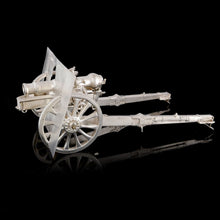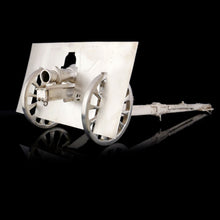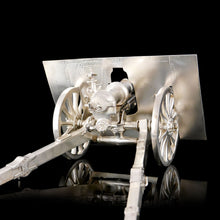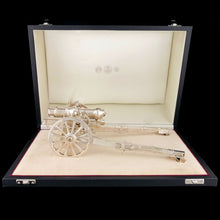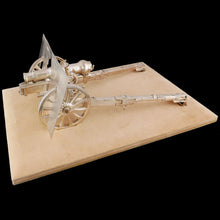A George V Presentation Model of a 3.7-Inch QF Mountain Gun, 1932
- Regular price
- £7,750
- Sale price
- £7,750
- Regular price
-
- Unit price
- /per
Adding product to your cart
10cm (4in) x 17cm (6.7in) x 26cm (10.2in)
Silver. Scale model featuring spoked wheels, interrupted screw breech, split trail to allow for a high angle of fire as suited for deployment in mountainous terrain, and rectangular shield intended to protect the crew from small-arms fire, but often omitted on active service to save weight. Maker’s mark of Falconer & Brown (Harry Falconer & Joseph Brown), Holm Street, Glasgow. Hallmarked Glasgow 1932. Contained in a travelling case.
The Quick Firing 3.7-inch howitzer was used by the mountain artillery regiments of the Royal Artillery and the Indian Artillery in the First and Second World Wars, and between the wars on the North West Frontier of India. It was first introduced in 1917, and was used in action in that year against the Turks in the Mesopotamian Campaign by the batteries of the 4th Highland Mountain Brigade, Royal Garrison Artillery which originally used highland ponies to transport their guns. The 22nd (Derajat) Indian Frontier Force mountain battery further deployed the new weapon into effect in an attack on German positions at Medo, in April 1918.
Read more
It was the immediate successor to the screw guns of Rudyard Kipling’s eponymous poem that, set to the tune of the Eton Boating Song, became the unofficial song of the Royal Garrison Artillery. A well-known lithograph by Snaffles depicting a mountain gunner striding out borrowed the opening lines for its title, viz:-
Smokin' my pipe on the mountings, sniffin' the mornin' cool,
I walks in my old brown gaiters along o' my old brown mule,
With seventy gunners be'ind me, an' never a beggar forgets
It's only the pick of the Army that handles the dear little pets.
The QF 3.7-inch was designed for use in terrain inaccessible to conventional guns and was transportable in pieces in eight mule loads. Given an open gun position, a practised crew could have the guns unloaded from the mules, reassembled and deployed ready for action in about two minutes. The 3.7-inch howitzer's adjustable suspension system allowed it to be deployed on almost any position, even those too uneven or with too steep a gradient to allow field artillery to be sited. The process of removing the howitzer from a position and reloading it onto the gun mules involved much more lifting and securing loads than deploying it, but could be accomplished in three minutes in favourable conditions.
When it was first introduced, the howitzer had two wooden wheels and was light enough be towed by two horses. Later marks have pneumatic tyres and could be towed by any light vehicle, such as the Bren Carrier or jeep. During the Second World War, the weapon was used in the North African Campaign and Italian campaigns, the Kokoda Trail campaign, the Burma campaign, and in the Netherlands and Ruhr fighting in 1944–45 by units originally destined for mountain warfare in Greece. In the latter theatre, on occasion the gun was dismantled and manually hauled up to the upper floors of buildings to provide close support in urban fighting. A lightened version was used briefly by airborne formations.








